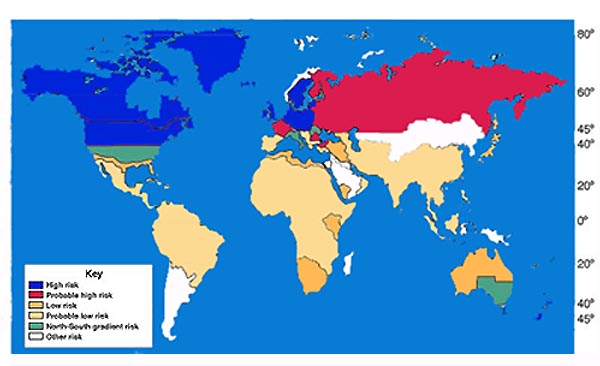Multiple sclerosis epidemiology and demographics
|
Multiple sclerosis Microchapters |
|
Diagnosis |
|---|
|
Treatment |
|
Case Studies |
|
Multiple sclerosis epidemiology and demographics On the Web |
|
American Roentgen Ray Society Images of Multiple sclerosis epidemiology and demographics |
|
Multiple sclerosis epidemiology and demographics in the news |
|
Risk calculators and risk factors for Multiple sclerosis epidemiology and demographics |
Editor-In-Chief: C. Michael Gibson, M.S., M.D. [1]
Overview
Epidemiology and Demographics
There is a lower frequency of people suffering from Multiple Sclerosis among citizens of the Arabian Peninsula, Asia, and continental South America than people living in northern Europe, continental North America, and Australasia, which is about one of every 1000 citizens. In addition, in sub-Saharan Africa, MS is extremely rare.[1] Several factors such as climate, diet, geomagnetism, toxins, sunlight exposure, genetic factors, and infectious have been proved to cause these regional differences. Also, Factors such as Childhood environmental factors may play an important role in progress of MS later in life. Various studies on migrants support this idea by stating that immigration occurs before the age of fifteen, the migrant acquires the new region's susceptibility to MS. But, if migration takes place after age fifteen, the migrant keeps the susceptibility of his home country.[2] However, other studies suggest larger timescale than the first 15 years of life for the growth of MS age/geographical risks.[3]
The occurrence of MS varies among countries for an unknown reason. Based on different studies, it has been proved that MS occurs mainly in Caucasians while in the Native American tribes of North America, Australian Aborigines and the Māori of New Zealand, MS is very rare. Also, among Canadians living in the same region, Inuit people have a twenty fold lower occurrence. Scotland appears to have the highest rate of MS in the world.[4] Therefore, it is supposed that probably due to either genetic background or lifestyle and cultural factors, the development of this disease is not equal in various regions. Moreover, as observed in many autoimmune disorders, MS is at least two times more common among women than men. However, males and females over age fifty, may have an equal ratio.This ratio among children may reach three females for each male. Onset of symptoms is mostly between age of fifteen to forty years, rarely before age fifteen or after age sixty. As previously discussed, genetic factors are an important component to MS. It is estimated that on average, one of every siblings of individuals with MS may develop this disease as well. Among identical twins of MS-affected individuals, almost half of them will develop MS, but only one of twenty fraternal twins. In addition, if one of the parents is affected by MS, the risk of developing MS for each child is about one in forty.[5]
In the end, it is important to highlight that some studies on related diseases have shown that some formerly considered MS cases are not MS at all. In fact, all the studies before 2004 can be affected by the impossibility to distinguish MS and Devic's disease (NMO) reliably before this date.[6]
-
World map showing that risk for MS increases with greater distance from the equator
References
- ↑ Epidemiology and multiple sclerosis. a personal review
- ↑ Marrie, RA. Environmental risk factors in multiple sclerosis aetiology. Lancet Neurol. 2004 Dec;3(12):709-18. Review. PMID 15556803
- ↑ Hammond SR, English DR, McLeod JG (2000). "The age-range of risk of developing multiple sclerosis: evidence from a migrant population in Australia". Brain. 123 ( Pt 5): 968–74. PMID 10775541.
- ↑ Rothwell PM, Charlton D (1998). "High incidence and prevalence of multiple sclerosis in south east Scotland: evidence of a genetic predisposition". J. Neurol. Neurosurg. Psychiatr. 64 (6): 730–5. PMID 9647300.
- ↑ Sadovnick, AD, Ebers, GC, Dyment, DA, Risch, NJ. Evidence for genetic basis of multiple sclerosis. The Canadian Collaborative Study Group. Lancet 1996; 347:1728. PMID 8656905
- ↑ Weinshenker B (2005). "Western vs optic-spinal MS: two diseases, one treatment?". Neurology. 64 (4): 594–5. PMID 15728277.
